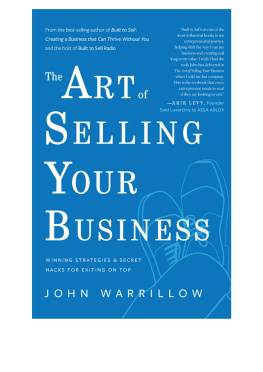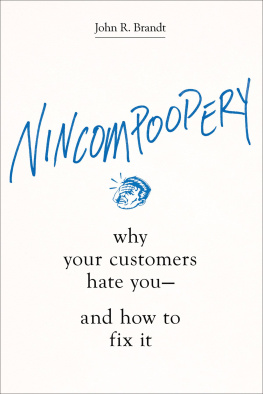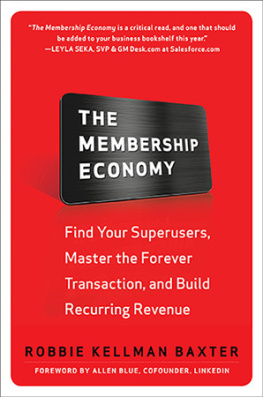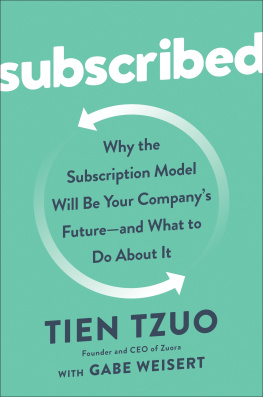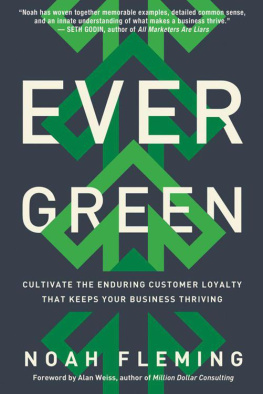John Warrillow - The Automatic Customer: Creating a Subscription Business in Any Industry
Here you can read online John Warrillow - The Automatic Customer: Creating a Subscription Business in Any Industry full text of the book (entire story) in english for free. Download pdf and epub, get meaning, cover and reviews about this ebook. year: 2015, publisher: Portfolio, genre: Business. Description of the work, (preface) as well as reviews are available. Best literature library LitArk.com created for fans of good reading and offers a wide selection of genres:
Romance novel
Science fiction
Adventure
Detective
Science
History
Home and family
Prose
Art
Politics
Computer
Non-fiction
Religion
Business
Children
Humor
Choose a favorite category and find really read worthwhile books. Enjoy immersion in the world of imagination, feel the emotions of the characters or learn something new for yourself, make an fascinating discovery.
- Book:The Automatic Customer: Creating a Subscription Business in Any Industry
- Author:
- Publisher:Portfolio
- Genre:
- Year:2015
- Rating:3 / 5
- Favourites:Add to favourites
- Your mark:
The Automatic Customer: Creating a Subscription Business in Any Industry: summary, description and annotation
We offer to read an annotation, description, summary or preface (depends on what the author of the book "The Automatic Customer: Creating a Subscription Business in Any Industry" wrote himself). If you haven't found the necessary information about the book — write in the comments, we will try to find it.
These days virtually anything you need can be purchased through a subscription, with more convenience than ever before. Far beyond Spotify, Netflix, and New York Times subscriptions, you can sign up for weekly or monthly supplies of everything from groceries (AmazonFresh) to cosmetics (Birchbox) to razor blades (Dollar Shave Club).
According to John Warrillow, this emerging subscription economy offers huge opportunities to companies that know how to turn customers into subscribers. Automatic customers are the key to increasing cash flow, igniting growth, and boosting the value of your company.
Consider Whatsapp, the internet-based messaging service that was purchased by Facebook for $19 billion. While other services bombarded users with invasive ads in order to fund a free messaging platform, Whatsapp offered a refreshingly private tool on a subscription platform, charging just $1 per year. Their business model enabled the kind of service that customers wanted and ensured automatic customers for years to come.
As Warrillow shows, subscriptions arent limited to technology or media businesses. Companies in nearly any industry, from start-ups to the Fortune 500, from home contractors to florists, can build subscriptions into their business.
Warrillow provides the essential blueprint for winning automatic customers with one of the nine subscription business models, including:
- The Membership Website Model: Companies like The Wood Whisperer Guild, ContractorSelling.com, and DanceStudioOwner.com offer access to highly specialized, high quality information, recognizing that people will pay for good content. This model can work for any business with a tightly defined niche market and insider information.
- The Simplifier Model: Companies like Mosquito Squad (pest control) and Hassle Free Homes (home maintenance) take a recurring task off your to-do list. Any business serving busy consumers can adopt this model not only to create a recurring revenue stream, but also to take advantage of the opportunity to cross-sell or bundle their services.
- The Surprise Box Model: Companies like BarkBox (dog treats) and Standard Cocoa (craft chocolate) send their subscribers curated packages of goodies each month. If you can handle the logistics of shipping, giving customers joy in something new can translate to sales on your larger e-commerce site.
This book also shows you how to master the psychology of selling subscriptions and how to reduce churn and provides a road map for the essential statistics you need to measure the health of your subscription business.
Whether you want to transform your entire business into a recurring revenue engine or just pick up an extra 5 percent of sales growth, The Automatic Customer will be your secret weapon.
John Warrillow: author's other books
Who wrote The Automatic Customer: Creating a Subscription Business in Any Industry? Find out the surname, the name of the author of the book and a list of all author's works by series.


